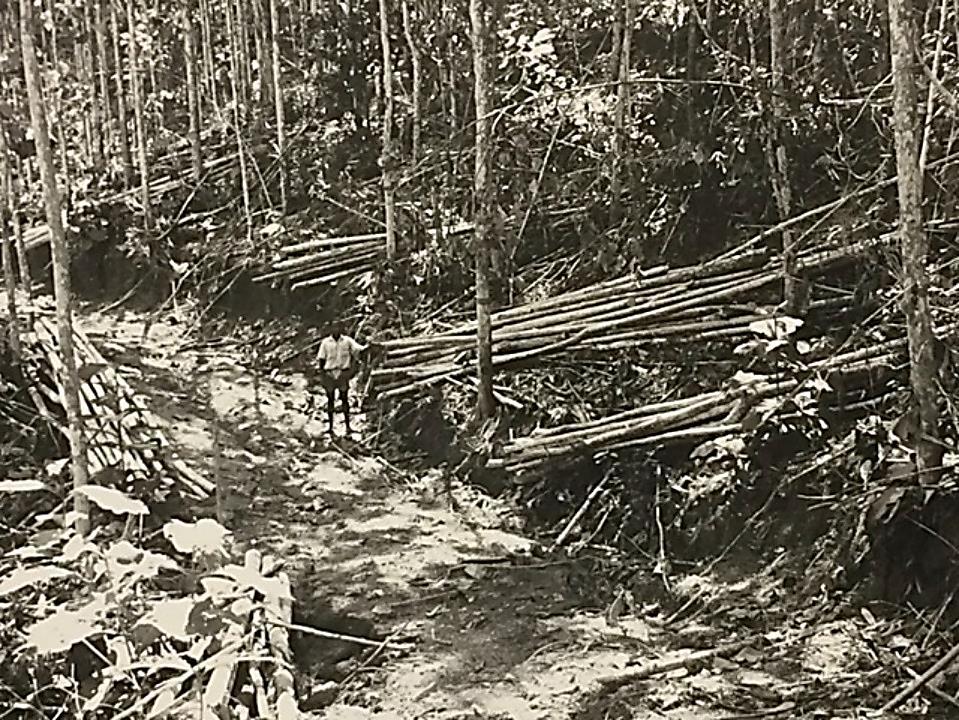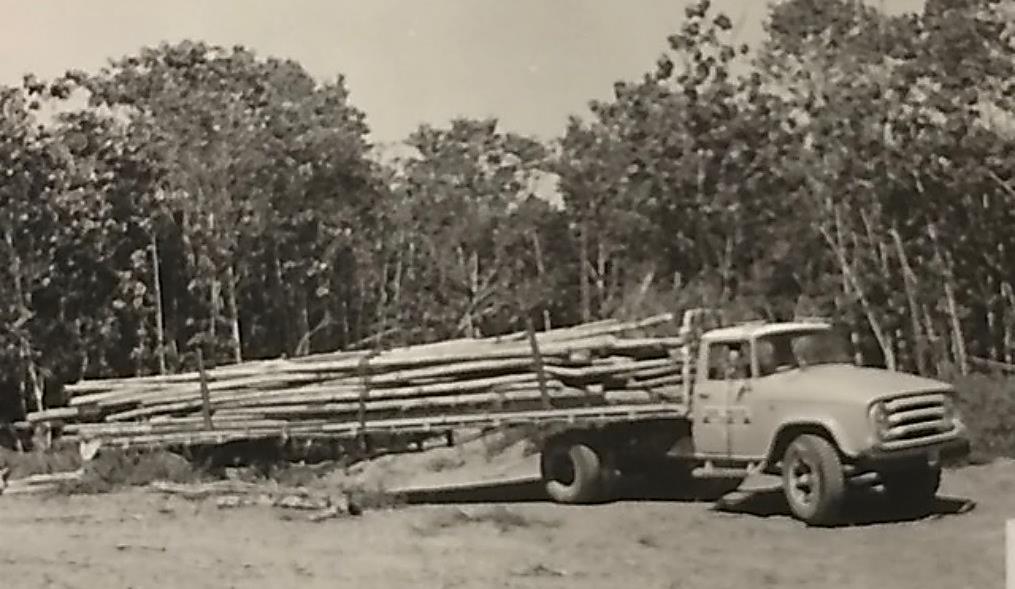
7 minute read
A Taste of Teak
from PNGAF MAGAZINE ISSUE # 9B-5B4H3 of 24th June 2022. Eminent TPNG Forester Des Harries.
by rbmccarthy
A TASTE OF TEAK27
Many young officers of Papua New Guinea’s Forestry Department, pre-Independence, experienced an introduction to the process of growing plantations of Teak trees.
Advertisement
All knew of the fame of Teak as one of, if not the premium timbers of the world. But it was very much a “foreign” entity - not an Australian, or for that matter, PNG thing - truly exotic.
However, this was the wet tropics, and Teak was a native of that environment in southern Asia. Also, the former German Administration had established trials prior to 1914. Those few Australian foresters who got to see these post-1945, must have been impressed enough by the species as an investment worth trying.
During 1957 a fifty-year-old tree was cut from the Kokopo plantation and sawn into planks at the Kerevat mill. This must have been an attempt to evaluate the potential of the product, and there is no doubt that this was seen to be satisfactory.
Photo 1. A sample taken from one of the boards produced. Photo Credit. Des Harries.
27 Personal communication Des Harries 8/9/21/
The result was the commencement in the early 1950s of the plantations at Kerevat and Brown River (Mt. Laws). At Kerevat, Teak, Techtona grandis and Kamarere, Eucalyptus deglupta, were grown on neighbouring blocks on the river flats, mostly in pure stands but also in admixture, with the faster grown, Kamarere being tried as a sort of “cover crop”, soon to be abandoned.
Still, there remained some doubt as to the wisdom of this investment and on the occasion of a pre-conference tour by some delegates to the Seventh British Commonwealth Forestry Conference, held in Australia, August to October 1957, Des recalls the then Director, Jim McAdam, intently probing experienced foresters for their opinions when the group visited Kerevat. Des thinks that not too much was gained from this, but certainly the program of planting Teak was not deterred.
At the Brown River, by 1971, the planting program had steadied at about 200 ha per year. But at Kerevat, the onset of local land ownership claims curtailed further planting.
Initially seed for the Kerevat plantation was collected from old German plantings near Kokopo and on New Ireland. In 1957 this was being organised by Regional Forest Officer, Alex Richardson and Regional staff officer, Ms. Lorraine Taylor.
The seed, sown in small nurseries, was allowed to grow into small plants which, at the time of planting out were cut into “stumps”. The planted “stumps” were protected from attack by the plague of giant African snails with cardboard rings soaked in snail deterrent.
Some years later a seed orchard was established at Kerevat in an area isolated from the main plantations. These selected trees were an important part of the Department of Forests’ Tree Improvement Program.
In 1971, the Forest Products Research Centre at Hohola, Port Moresby, conducted a Teak plantation thinning trial at Brown River, with the cooperation of the then OIC, Bob Bruce.
The thinnings were cut into squared poles for low-cost building, for which there was a high demand around Port Moresby.
Studies of the wood in these thinnings showed that while the true heartwood had the natural durability associated with Teak, there was an ‘intermediate zone’ of lesser durability between the heartwood and the sapwood. The latter was distinguishable on the basis of its colour, but not so the ‘intermediate zone’. It seemed anomalous that an artificial preservative treatment was necessary to obtain a durable product from these teak plantations. Such a treatment certainly diminished the demand for these products for low-cost structures, as the builders of such structures would have preferred the lower cost of untreated wood. Nevertheless, the Forest Products Research Centre included the pressure treatment of thinnings products in its trial, preliminary leading to a marketing study.

Thinnings ready for skidding along a skid track constructed using a Caterpillar D6 Tractor operated by Bob Cattanach from Bulolo. Photo credit. Des Harries.
Des Harries with small Massey Ferguson Crawler Tractor loaned for the exercise, by Ela Motors, Port Moresby. It proved too small for the skid track construction task. Photo Credit. Des Harries.
Photo 4. A load of teak thinnings as taken to the Forest Products Research Centre at Hohola, Port Moresby. Photo Credit. Des Harries.



A large market stall using CCA treated teak. Source Col Levy 1975 paper Wood preservation in PNG.

A simple market stall using treated teak and bamboo in Port Moresby.
Source Col Levy 1975 Paper Wood preservation in PNG.

A low cost house using CCA treated teak and bamboo. Source Col Levy 1975 paper Wood
preservation in PNG.
Project Brief
A LOGGING AND UTILISATION STUDY OF TEAK PLANTATION THINNINGS IN THE CENTRAL DISTRICT OF PAPUA.
Forest Products Research Centre, Hohola, Port Moresby, PNG. Des Harries.
Introduction
The Department of Forests has been engaged in the establishment of Teak (Tectona grandis) plantations in the Central District of Papua since 1954. Until 1964 annual planting areas were small, commensurate with the pilot nature of such reforestation and limited availability of suitable seed at that time.
The choice of Teak as a reforestation species was influenced by a number of factors, some of which have become redundant due to changing demands in the market and technology in the timber industry. The species is suitable for the monsoonal climate and soils of the lower foothills in this District. It's growth rate from early trials appeared satisfactory.
The intrinsic value of Teak is based on the remarkable natural durability and stability of its heartwood. However, with the development of chemical timber preservation methods the durability factor has been largely superseded by its stability and appearance for high-class furniture. Even its remarkable stability has largely become a redundant property as a result of the wide-spread development of thin veneers on a stable plywood or particle board structure. We are thus left with the characteristic appearance of teak, combined with the world-wide fame of the name, as the major selling feature of Teak wood.
The distinct appearance of the wood, for which it is now largely sought, is dependent on the ring porous structure and seasonal deposits giving textural and colour patterns to the finished wood surface. It has become apparent that to develop this characteristic, teak must be grown on sites where the combined effect of seasonal drought and poorer soils result in the essential periodic growth restraint, with ‘growth rings’ at fairly close intervals.
Because the market for high quality cabinet woods is a limited one and has an ever-present risk of disappearing due to the whims of furniture fashions and development of substitutes, other end-uses are required to justify plantation establishment. These end-uses appear to be sawn timber, mainly for local use, plus round material from younger thinning’s for use as posts, poles, etc.
With the rapid growth of population in the Port Moresby area the demand for such building materials is intensifying. There should be little difficulty in disposing of the products from the current plantation programs of 400 acres per annum, the yield of thinning’s from which will taper off to a constant level over the next ten years.
The initial problems of utilising material from these plantations is intimately involved with developing the most satisfactory products from the early thinning’s to meet local demand. While these thinning operations constitute a necessary silvicultural treatment in the
course of producing high quality wood it must be done as cheaply as possible. Even a small economic return from the thinning’s material is advantageous, particularly if a demand for this type of raw material is satisfied at the same time.
A combination of factors has precipitated this study. The first was the desirability of finding a commercial outlet for the early teak thinning’s, and at the same time meeting an increasing local demand for such products as could be developed from them. The second following from the first, was the need to develop a method of harvesting most suitable for local conditions and which would be adaptable to a commercial thinning operation.
Outline of the project
This project was initiated following discussions in July 1971 between staff of the Regional Forest Office, the Forest Products Research Centre and the Manager, Equipment Division, Ela Motors Pty. Limited, Port Moresby.
The following steps were planned: -
(a) An initial appraisal of the local market potential for the type of product which we could expect to be produced from teak thinning’s - house stumps, fence posts, road marker posts, etc.
The use of pressure treated round timbers in these categories appeared most promising.
(b) A thinning’s extraction study covering the range of topographical conditions in the teak plantations.
(c) A pilot study on the production of marketable products from the thinning’s material, covering seasoning, debarking, grading, pressure treatment and product handling methods.
Finally using the stock of end products obtained, market promotion and education was to be commenced.








